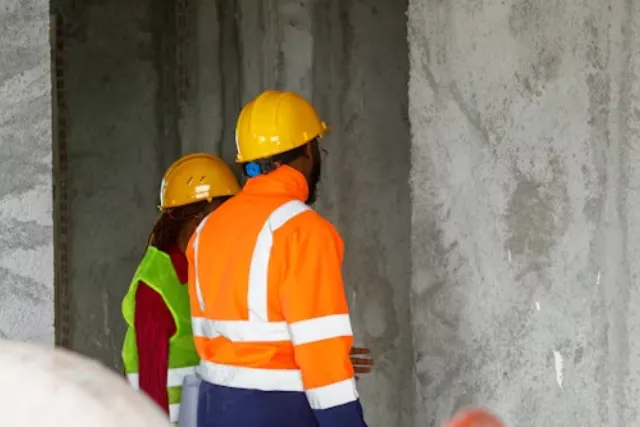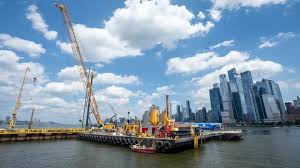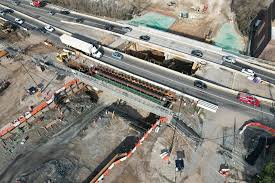
NEW YORK — The future of a key piece of the massive Gateway rail tunnel program is facing pushback over a labor dispute that could determine which contractors are allowed to bid.
At the heart of the controversy is a project labor agreement (PLA) tied to the New Jersey Surface Alignment program — a critical phase that will build tracks, rail bridges, and other infrastructure between North Bergen and Secaucus as part of the $16 billion Hudson River rail improvement plan.

During its July 28 meeting, the Gateway Development Commission (GDC) revised its approach to the labor agreement after George Harms Construction Co., a major New Jersey-based firm, argued it may be unfairly excluded because the PLA does not cover the United Steelworkers (USW) — the union representing its workforce.
“Harms was deemed qualified to bid, and yet the commission still moved forward with a PLA that excludes the very union we are organized with,” said Rob Harms, CEO of the Farmingdale company, during the public comment session. “If the project labor agreement… were to proceed without including the United Steelworkers, Harms would be unable to bid on the project.”
PLAs are widely used on large public construction projects to standardize employment terms and secure reliable union labor. According to Catherine Rinaldi, GDC’s executive vice president, PLAs benefit both workers and project owners by ensuring access to a skilled, well-trained workforce that can mobilize quickly and safely.
“PLAs benefit workers and will enable the GDC to build efficiently by giving contractors access to an experienced, well-trained pool of workers who can quickly mobilize and create opportunities for apprenticeship programs,” Rinaldi said.
However, the PLA for this segment — between the GDC and the Hudson County Building and Construction Trades Council — does not list the USW among its participating unions. It does include several influential local labor groups: Laborers Locals 472 and 172, Operating Engineers Local 825, Iron Workers Local 11, Masons Locals 4 and 5, Teamsters Local 560, Dockbuilders Local 1556, and Electricians Local 164.

Harms’ lawyer, Corinne Burzichelli DeBerry of Fox Rothschild, said the issue isn’t new. The company faced a similar situation when its union was left out of the PLA for the Palisades Tunnel Project.
“Harms was told, in no uncertain terms, that the reason for the exclusion was because they were not pre-qualified and none of the contractors that were pre-qualified were organized with USW,” DeBerry explained. “This time, Harms is pre-qualified, and it appears the USW will be excluded again, which will prevent Harms from bidding this contract.”
Harms Construction has clashed with other public agencies over PLAs in the past, including lawsuits against the New Jersey Turnpike Authority and the Delaware River Joint Toll Bridge Commission, arguing that excluding its union violates competitive bidding laws.
The Surface Alignment work is just one piece of the broader Gateway Program — which includes building a new two-track Hudson River tunnel between New Jersey and Manhattan and rehabilitating the aging tunnel that currently carries Amtrak and NJ Transit trains under the river. The old tunnel, over 100 years old and damaged by Superstorm Sandy, causes regular delays and malfunctions for thousands of commuters.
“A project labor agreement is one in which you’re trying to establish a level playing field for work rules and wage rates so all the parties that are submitting bids for the work are getting it from the same sheet of music,” said Thomas Prendergast, GDC’s CEO and a veteran transit executive.
After Harms voiced its concerns, the board unexpectedly entered a closed-door executive session for nearly an hour. When they returned, they amended the resolution — requiring Prendergast to bring the final PLA back to the board for a separate vote before it’s finalized.
Alicia Glen, GDC co-chair, read the amendment aloud, and the board voted unanimously to approve the change.
GDC spokesperson Stephen Sigmund emphasized that PLAs have been standard practice on Gateway projects so far, including the Palisades Tunnel, and will continue to be used to maintain clear work and wage rules.
“PLAs are obviously a very important part of having work rules and wage rules in place that give us certainty and that helps keep the project on scope, schedule and budget,” Sigmund said. “We’ve had PLAs on each of the contracts so far. We’ll have them on the contracts going forward.”
He added that no one is explicitly excluded from bidding, but the final language will determine whether George Harms Construction can participate this time.
With the Surface Alignment project critical to the timeline of the Hudson River tunnels, the resolution of this labor dispute could affect how soon construction ramps up — and which contractors are allowed to compete for the billions of dollars in contracts that remain.
Originally reported by Colleen Wilson in North Jersey.